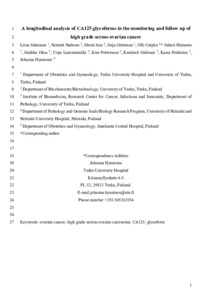A longitudinal analysis of CA125 glycoforms in the monitoring and follow up of high grade serous ovarian cancer
Liina Salminen; Nimrah Nadeem; Shruti Jain; Seija Grènman; Olli Carpén; Sakari Hietanen; Sinikka Oksa; Urpo Lamminmäki; Kim Pettersson; Kamlesh Gidwani; Kaisa Huhtinen; Johanna Hynninen
https://urn.fi/URN:NBN:fi-fe2021042826845
Tiivistelmä
Objective
Cancer antigen 125 (CA125) is generally considered the gold standard of biomarkers in the diagnosis and monitoring of high grade serous ovarian carcinoma (HGSC). We recently reported, that two CA125 glycoforms (CA125-STn and CA125-MGL) have a high specificity to HGSC and further hypothesized, that these cancer specific glycoforms are feasible candidates as biomarkers in HGSC treatment and follow up.
Methods
Our cohort consisted of 122 patients diagnosed with HGSC. Serum samples were collected longitudinally at the time of diagnosis, during treatment and follow up. Serum levels of CA125, CA125-STn and CA125-MGL were determined and compared or correlated with different end points (tumor load assessed intraoperatively, residual disease, treatment response, progression free survival).
Results
Serum CA125-STn levels at diagnosis differentiated patients with low tumor load and high tumor load (p = 0,030), indicating a favorable detection of tumor volume. Similarly, the CA125-STn levels at diagnosis were significantly lower in patients with subsequent complete cytoreduction than in patients with suboptimal cytoreduction (p = 0,025). Conventional CA125 did not differentiate these patients (p = 0,363 and p = 0,154). The CA125-STn nadir value predicted the progression free survival of patients. The detection of disease relapse was improved with CA125-STn, which presented higher fold increase in 80,0% of patients and earlier increase in 37,0% of patients.
Conclusions
CA125-STn showed promise as a useful biomarker in the monitoring and follow up of patients with HGSC utilizing a robust and affordable technique. Our findings are topical as a suitable indicator of tumor load facilitates patient selection in an era of new targeted therapies.
Kokoelmat
- Rinnakkaistallenteet [27094]
